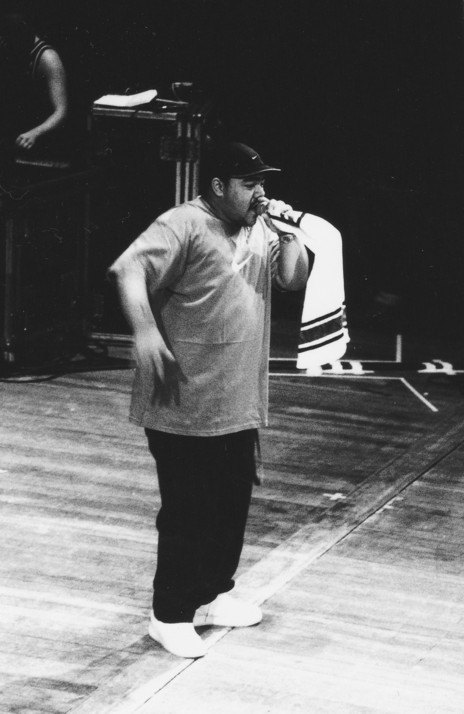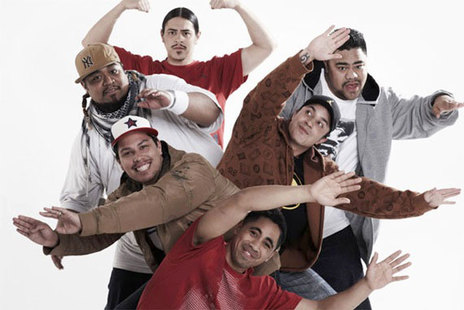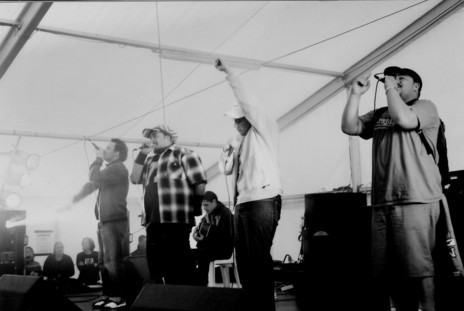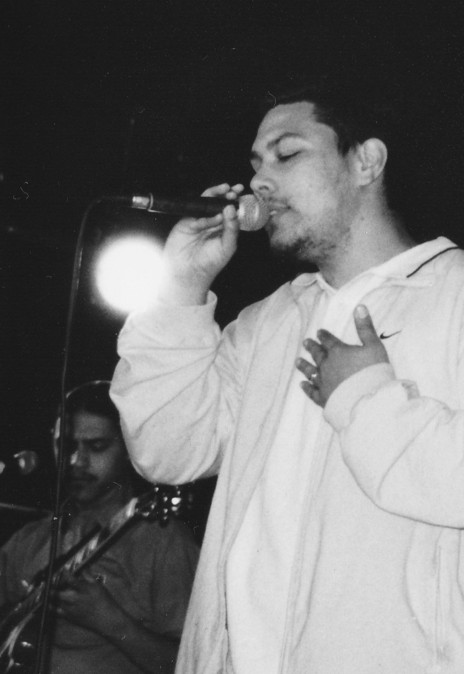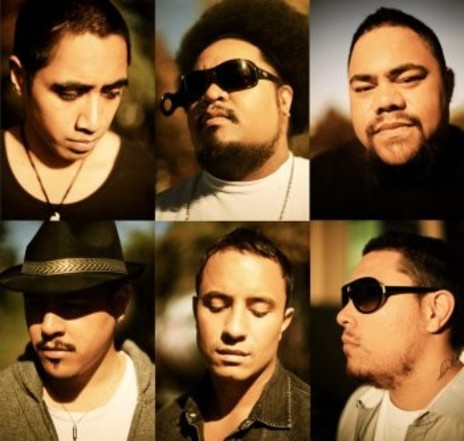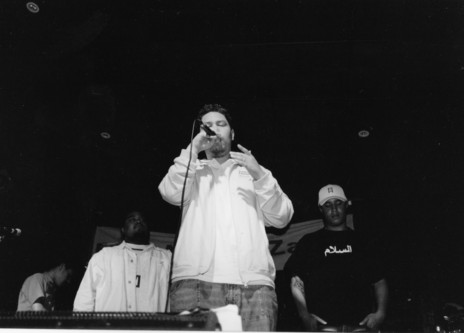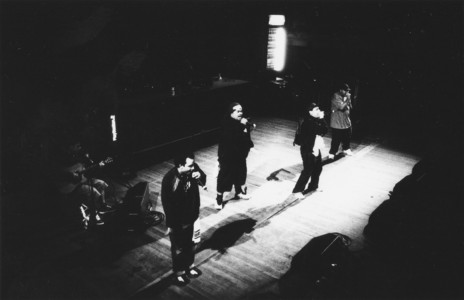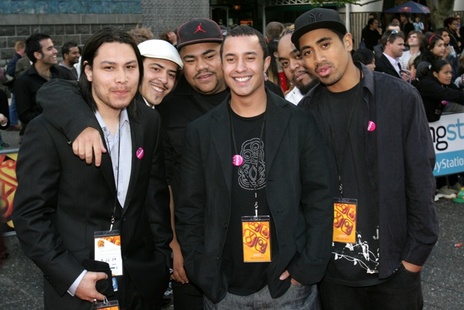McNulty also had a long history making music with St Paul’s College student, Feleti Strickson-Pua (Sabre), who learned to rap from a cousin who stayed at his house for a year, Malo Luafutu (aka Scribe). Strickson-Pua recalls how he met McNulty. “I started off in a group called Fa’atasi and during our second gig ever, Donald saw us perform and he was real taken. We talked and ever since then we’ve been writing together. My dad [Reverend Mua Strickson-Pua] used to put on poetry nights at the Dead Poets Cafe so me and Donald would perform whatever songs we were doing at the time.”
The buzz around the group spread quickly and before they even left high school, they were signed to Bounce Records, run by Dean Godward.
The buzz around the group spread quickly and before they had even left high school, they were signed to Bounce Records, run by Dean Godward (aka Cuba from Del Rey System/Cuba & Gizmo). This deal gave them distribution through Universal Records and by the end of 2001 they had a single, ‘Nesian Style’, in the Top 10.
Fortunately, the group had a gifted musician/beat-maker in David Atai, though initially the only software he had to hand was a PlayStation program called Music 2000 which he used to create the foundation of their early tracks (ironic, since the group went on to be sponsored by Xbox). When they came to record an album it also helped that they had the production talent of Godward and Simon Holloway (Beaver studio), as well as veteran keyboardist Godfrey de Grut (who also played sax when required).
Strickson-Pua was also excited when Che Fu agreed to collaborate. “That was the opportunity of a lifetime. He’d always given us feedback and had been a mentor that we’d always looked up to. So we asked him to do a track and he was like ‘yeah man, definitely’. All credit to the guy, it almost didn’t get on the album because we were taking so long with it. He really provided the whole basis to the song in the end.”
Che Fu provided a good template for the group, pushing beyond the usual rap audience into the mainstream with his powerful voice, the positive messages in his raps and his ability to switch between R&B, hip hop and reggae. Nesian Mystik took a similar approach, but had the added advantage of having six talented group members: Awa’s soulful singing melded with his laidback rapping style; Atai’s guitar work could move from funk to reggae to Polynesian-style with ease; McNulty and Rikiau brought the edginess of underground hip hop to their rhymes; Strickson-Pua brought a lyricism that helped the group push beyond the cliched phrases (even before he officially joined, he had written rhymes for the group); and not forgetting Heath Manukau, who humbly stayed out the limelight during their first release (despite adding scratching to a couple of tracks), before returning as a full-fledged member from their second album onward.
Given the group had ancestral roots that included Māori, Cook Island, Tongan, and Samoan (as well as Palagi), they were a surefire hit with Auckland’s Polynesian community, but the trick was to get beyond this. Fortunately, their next two singles had perfect hook-laden choruses and the multiple members rapping and singing over one another gave the sense of party going on.
‘It’s On’ went to No.2 and ‘For The People’ hit No.5 (later winning the APRA Silver Scroll Award). This helped push their subsequent album, Polysaturated (2002), to the top of the charts and it stayed in the Top 40 for over a year (eventually reaching four-times platinum).
All of this was before Scribe had his first hit, though his arrival opened the Australian market, as McNulty later explained. “It definitely helped when Scribe and Savage got noticed in Australia and they both got nominated in the MTV Australia Music Awards … It meant we could build up a fanbase over there, though at the start it was mostly Kiwis who’d moved over. People over there dug our sound as well because we didn’t sound American – we were still rapping with our Kiwi accents and not trying to play off the whole bling-bling approach.”
The success of Polysaturated also took them to the UK, where they played industry showcases and club shows in London.
They soon reached the point where they could sell out 600-plus capacity venues in Australia, as well as being a headline act for large scale events like the NZ Hip Hop Summit and Edgefest. The success of Polysaturated also took them to the UK, where they played industry showcases and club shows in London. In the meantime, David Atai had set up his own studio running Logic, so the days of PlayStation beats were well behind them.
Screenwriter/playwright Oscar Kightley had already contributed an introductory skit to Nesian Mystik’s first album, and when he came to make the show bro’Town he brought Atai & McNulty onboard to provide the music. Around the same time, Awa fronted a campaign for awareness of meningococcal disease – a cause that was close to his heart, since he had almost died from the illness at 15.
Given all this, it was hardly surprising that their second album, Freshmen (2006), took six years to arrive. Atai’s guitar playing showed a new sharpness, most notably the flamenco-influenced acoustic playing on Top 10 single ‘What’s Next’.
However the album also showed Atai coming into his own as a producer, with deeply funky tracks such as ‘People’ (with horns by The WBC) and ‘So Good’ (with horns by One Million Dollars). The second single, ‘If It’s Cool’, took its sample from ‘Shout To The Top’ (by The Style Council/Paul Weller) to create an upbeat party track, which charted at No.5 and helped the album to No.8.
The subsequent tour saw Nesian Mystik taking their music to more countries than ever before, starting with shows in the Cook Islands, Fiji and Tonga.
“In the islands, they’d heard of us,” says Atai, “because most of them have family in New Zealand who send music over. They’re also quite small places, so whether you’re big or not, if there’s a show on, then people will check it out. We played in the basketball stadium in Rarotonga and it was quite full, so I’m guessing that was everybody on the island! ... Japan was also crazy for us, we were like kids in a giant candy store. We played four cities – Tokyo, Osaka, Fukuoka, Nagoya – so we pretty much went up and down the main island … By the time we got to Australia there was already a general recognition that New Zealand hip hop was quite good, so that helped. Cheers Scribe!”
Their experience in Japan led to Atai writing music for pop group Kasumi, who reached the top of iTunes in Japan with the song they made to his music. Nesian Mystik then reworked the same backing track as Top Five single, ‘Dancefloor’ and the rapper Toshi from Kasumi appeared on another Nesian track, ‘Game Over’.
It seemed crucial that their next album not suffer delays that had belaboured Freshmen, so the group started work on it as soon as they were back from tour. The seventies funk/disco influence that had begun to creep in on their last album came to full fruition on Elevator Musiq (2007) and Atai put aside his guitar for many of the tracks, instead basing them around upfront synth parts or horn lines (played by ex-members of the now-defunct One Million Dollars).
Dean Godward later admitted that the change in direction meant that he found it hard to get the first single, ‘Nesian 101’, on commercial radio. “Mai FM were the only station that would champion it at first, so we used YouTube and Bebo to gain interest in the track. We had a meeting where we discussed pulling the track and putting out another single, but during that week it just went crazy. Next thing you know, it’s at No.1.”
Elevator Musiq subsequently hit No.12, buoyed by a third hit single, ‘Mr Mista’, featuring Che Fu and Kimbra. Atai had met Kimbra many years earlier when she was representing APRA at Pasifika Festival and he had taken time out to show her a few chords on the ukulele. The album’s roster of talent didn’t stop there, with Young Sid (aka Sydney Diamond) adding some street edge to ‘You Already Know’ while PNC dropped a slick verse on hit single ‘RSVP’.
The golden years of New Zealand hip hop may have passed, but Nesian Mystik had long outlasted the hype and in 2009 picked up an Australian MTV Music Award for Best Kiwi Act, despite never having any official releases in Australia. Yet there were increasing pressures on the group since many of them now had families to support and the income they made from the group wasn’t steady enough to rely on (especially once digital downloading became a factor). It was therefore no surprise when their final album, 99 AD, was accompanied by a farewell performance on primetime current affairs show, Close Up, on 27 July 2010.
The group members hoped to release new music individually through their own label, Arch Dynasty, which had taken over full control from Bounce for their final release. Nesian Mystik continued to play live together, but no longer produced new music as a group. Nonetheless their final album still managed to produce a last hit single, the aptly named ‘Sun Goes Down’. This solidified their record of having the most Top 10 singles on the New Zealand chart by a local artist: 11 Top 10 singles in all.
In the years that followed, Awa emerged as solo artist and put a strong focus on incorporating te reo Māori into his lyrics. This work led to Awa and David Atai becoming the only songwriters thus far to win both an APRA Silver Scroll and an APRA Maioha award (their joint composition with Scotty Morrison, ‘Matahīapo’, won in 2012). Native Intel EP (2011) dipped into the Top 40, while tracks off his Heartbeat EP (2015) received commercial airplay in Japan and Hawaii (most notably, ‘Perfect Day’, which featured Hawaiian pop diva, Anuhea and gained 1.5 million views on YouTube).
In many ways, Awa could be seen as continuing on the quest that Nesian Mystik had set themselves from the start. The positive approach they took to making music was nicely summarised by Strickson-Pua during the early years of the group. “It’s really about uplifting our communities, encouraging those that are coming up, and ensuring that the stories of those who’ve come before us shall be told and that we shall continue on the legacy of our origins.”
